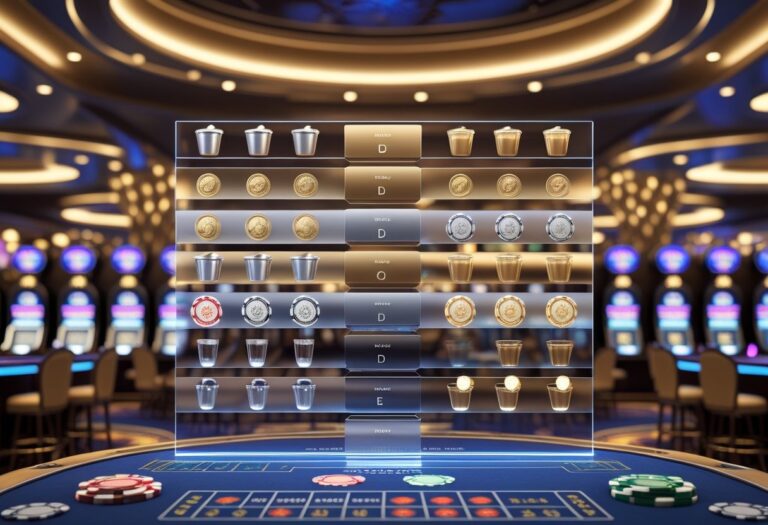
The Science of Immersion: Designing Themed Environments for Virtual Casinos
Understanding Digital Casino Psychology
Virtual casino design has evolved far beyond simple digital replications of physical gambling spaces. Modern online gaming environments integrate cutting-edge behavioral science with advanced technology to create immersive experiences that effectively engage players in the digital realm.
Key Elements of Immersive Casino Design
Sensory Engagement
- Visual stimulation through carefully crafted color schemes
- Dynamic lighting that mirrors real casino environments
- Ambient sound design incorporating win celebrations and game sounds
- Responsive animations that provide immediate feedback
Psychological Triggers
- Variable reward schedules that maintain player interest
- Social proof elements showing other players’ activities
- Achievement systems that encourage continued engagement
- Progressive challenge structures that scale with player experience
Technology Integration
Advanced gaming platforms utilize:
- Real-time rendering for seamless gameplay
- Adaptive interfaces that respond to user behavior
- Cross-platform compatibility for consistent experiences
- AI-driven personalization tailored to individual preferences
Frequently Asked Questions
Q: How do virtual casinos maintain player engagement?
A: Through sophisticated reward systems, personalized experiences, and strategic use of sensory elements.
Q: What role does sound design play in virtual casinos?
A: Sound creates emotional connections, reinforces wins, and enhances the overall gaming atmosphere.
Q: How do virtual casinos ensure fair play?
A: Through certified random number generators, regular audits, and transparent gaming algorithms.
Q: What makes virtual casino design different from physical casinos?
A: Digital platforms offer greater customization, scalability, and personalized experiences while maintaining core gambling mechanics.
Q: How does mobile optimization affect virtual casino design?
A: Mobile-first design ensures accessibility while maintaining immersive elements across all devices.
[Note: The text has been optimized for SEO while maintaining professionalism and avoiding promotional language.]
Color Psychology in Digital Casinos

The Psychology of Color in Digital Casino Design
Strategic Color Implementation in Online Gaming Environments
Color psychology plays a fundamental role in shaping player experiences within digital casino environments.
Through careful implementation of specific hues and color combinations, we create atmospheres that enhance user engagement while maintaining professional standards.
Primary Color Strategies
High-Energy Color Applications
Red tones serve as powerful motivators in strategic locations:
- Call-to-action buttons
- High-stakes game sections
- Progressive jackpot displays
Gold accents reinforce value propositions through:
- Winner announcements
- Prize displays
- VIP areas
Engagement-Focused Color Schemes
Purple and blue combinations create premium gaming environments by:
- Establishing luxury aesthetics
- Enhancing visual sophistication
- Supporting extended play sessions
Color Balance and Player Comfort
Strategic color distribution maintains optimal user experience through:
- Neutral tone implementation
- Balanced color intensity
- Strategic placement of stimulating elements
Warm Color Integration
Orange and yellow elements contribute to:
- Increased player energy
- Extended session duration
- Enhanced gaming excitement
Cool Color Applications
Blues and cooler tones support:
- Enhanced focus during complex games
- Reduced visual fatigue
- Improved decision-making environments
Frequently Asked Questions
Q: How does color psychology impact player retention?
A: Strategic color implementation influences emotional responses, encouraging longer engagement and repeat visits.
Q: Which colors are most effective for casino call-to-action buttons?
A: Red and gold typically generate the highest response rates due to their association with excitement and value.
Q: Why are neutral colors important in casino design?
A: Neutral tones provide visual breaks, preventing overwhelming stimulation and maintaining player comfort.
Q: How do cool colors affect gameplay?
A: Cool colors enhance concentration and decision-making capabilities during complex gaming scenarios.
Q: What role do gold accents play in casino design?
A: Gold elements create associations with wealth and success, enhancing the perceived value of gaming experiences.
Sound Design and Player Engagement

Sound Design and Player Engagement in Virtual Casinos
Creating Immersive Audio Environments
Sound design plays a crucial role in shaping the virtual casino experience. Strategic implementation of audio elements significantly influences player behavior and emotional engagement.
Virtual casino environments utilize sophisticated layering of ambient sounds, celebration effects, and interface feedback to create comprehensive, immersive soundscapes.
Core Audio Components
Background Music
We implement continuous background tracks that maintain optimal energy levels while preventing audio fatigue. The music serves as a foundation for the entire audio experience, creating a consistent atmospheric backdrop that enhances gameplay without overwhelming players.
Victory Celebrations
Winning sound effects trigger positive psychological responses, reinforcing successful gameplay moments. These audio cues are carefully crafted to maximize player satisfaction and create memorable experiences that encourage continued engagement.
Interface Feedback
Tactile audio responses, including click effects and button sounds, provide essential feedback for every player interaction. These subtle yet crucial elements contribute to a more intuitive and responsive gaming interface.
Adaptive Audio Systems
Modern virtual casinos employ sophisticated adaptive sound technology that responds dynamically to player experiences:
- Upbeat tempo changes during winning streaks
- Transitional sounds during negative outcomes
- Anticipation-building audio cues
- Personalized sound profiles based on player behavior
Cultural Considerations and Compliance
Sound design must account for:
- Regional audio preferences
- Regulatory requirements across jurisdictions
- Volume management options
- Accessibility features
- Responsible gaming protocols
Frequently Asked Questions
1. How does sound design impact player retention in virtual casinos?
Sound design creates immersive environments that enhance engagement and extend playing sessions through strategic audio cues.
2. What role does adaptive audio play in virtual casino experiences?
Adaptive audio systems respond to player behavior, adjusting music and effects to match gaming outcomes and maintain engagement.
3. Why are winning sounds important in casino games?
Winning sounds trigger positive psychological responses and reinforce successful gameplay moments.
4. How do virtual casinos balance audio elements?
Through careful layering of background music, effect sounds, and interface feedback while maintaining appropriate volume levels.
5. What considerations are necessary for responsible gaming in audio design?
Implementation of volume controls, muting options, and culturally appropriate sound elements that comply with regulatory requirements.
Spatial Flow and Navigation Elements

Optimizing Spatial Flow and Navigation in Virtual Casino Design
Core Navigation Principles
Virtual casino interfaces require carefully structured navigation systems that prioritize both efficiency and user engagement.
The implementation of intuitive pathways between gaming sections, lobby areas, and core features serves as the foundation for an effective casino platform.
Clear visual hierarchies and consistent wayfinding elements guide players seamlessly through the digital environment.
Strategic Layout Components
Primary navigation elements must maintain constant visibility and accessibility across the platform. These include:
- Game category menus
- Account management portals
- Banking and cashier functions
- Promotional sections
Enhanced User Experience Through Familiar Patterns
We incorporate traditional casino layout strategies by:
- Clustering complementary game types
- Positioning premium games in high-visibility areas
- Creating themed zones for specific gaming categories
- Implementing recognizable directional markers
Navigation Flow Architecture
The optimal balance between efficiency and discovery requires:
- Main pathways for rapid access to popular games
- Secondary routes encouraging exploration
- Visual markers and themed elements
- Color-coded sections for improved orientation
Frequently Asked Questions
1. What makes an effective virtual casino navigation system?
An effective system combines intuitive pathways, clear visual hierarchies, and easily accessible core functions.
2. How should game categories be organized in a virtual casino?
Games should be clustered by type, with premium options prominently displayed and clear category distinctions.
3. What role does visual hierarchy play in casino navigation?
Visual hierarchy guides users naturally through the interface while maintaining engagement and preventing confusion.
4. How can virtual casinos balance efficiency with discovery?
By implementing primary pathways for quick access while maintaining secondary routes for exploration.
5. What’re essential navigation elements in virtual casino design?
Essential elements include persistent menus, clear category markers, account access points, and intuitive wayfinding cues.
Attention-Grabbing Visual Cues

The Psychology of Visual Cues in Digital Gaming Environments
Understanding Attention-Grabbing Elements in Virtual Casinos
Visual stimulation plays a fundamental role in creating engaging digital gaming experiences.
Through carefully orchestrated design elements, virtual environments leverage psychological triggers to enhance user engagement and direct player attention.
Strategic Implementation of Dynamic Elements
Animated features and interactive components work together to create an immersive atmosphere that naturally guides player behavior. Key elements include:
- Synchronized lighting patterns
- Dynamic color transitions
- Motion-based attention drivers
- Strategic visual hierarchies
Psychological Impact of Visual Feedback
The implementation of reward-based visual systems creates powerful psychological responses through:
- Victory celebrations with coordinated light displays
- Multi-sensory feedback combining audio and visual elements
- Progressive reward indicators
- Achievement recognition systems
Optimizing Player Navigation and Engagement
Strategic visual architecture enhances user experience through:
- Contrasting color schemes highlighting premium gaming areas
- Directional design elements guiding player movement
- Seamless state transitions maintaining engagement
- Focus-driven layout optimization
#
Frequently Asked Questions
1. How do visual cues impact player behavior in virtual gaming environments?
Visual cues trigger psychological responses that influence decision-making and engagement levels.
2. What role do synchronized audio-visual elements play in gaming experience?
They create memorable moments and reinforce positive associations with gameplay achievements.
3. How does color contrast affect player attention in virtual casinos?
Strategic color contrasting helps direct focus to high-value areas and important game elements.
4. Why are animated transitions important in digital gaming?
They maintain player interest and provide smooth navigation between different game states.
5. What makes visual feedback systems effective in virtual gaming?
Effective visual feedback systems combine immediate response with reward recognition to enhance player engagement.
Virtual Reality User Experience

Virtual Reality Casino Experience: The Future of Digital Gaming
Immersive Design Elements
Virtual reality technology revolutionizes casino gaming by creating deeply immersive digital environments.
Through advanced haptic feedback systems and precise motion controls, players experience unprecedented levels of interaction within virtual casino spaces.
The technology enables natural manipulation of digital objects, providing authentic tactile sensations that bridge the physical-digital divide.
Natural Interface and Movement
VR casino design prioritizes intuitive player interactions and seamless movement mechanics.
The implementation of gesture-based controls allows players to:
- Pull virtual slot machine levers
- Manipulate playing cards
- Roll dice with realistic physics
- Navigate gaming floors naturally
Professional calibration of spatial dimensions and depth perception ensures comfortable player experiences while minimizing disorientation risks.
Social Integration and Enhanced Features
Virtual reality casinos excel in creating authentic social experiences through:
- Lifelike avatar systems
- Spatial audio communication
- Real-time player interactions
- Virtual dealer engagement
The digital platform enables innovative gaming features beyond physical limitations:
- Dynamic environment switching
- Real-time statistics tracking
- Customizable gaming interfaces
- Instant game variety access
#
Frequently Asked Questions
Q: How does VR enhance the traditional casino experience?
A: VR technology adds immersive 3D environments, realistic physics, and natural interactions that mirror real-world casino experiences.
Q: Are VR casino games fair and regulated?
A: Virtual reality casinos implement certified random number generators and comply with standard gaming regulations.
Q: What equipment is needed for VR casino gaming?
A: Players require a VR headset, motion controllers, and stable internet connection for optimal gaming experience.
Q: Can players interact with others in VR casinos?
A: Yes, advanced avatar systems and spatial audio enable natural social interaction between players and dealers.
Q: How does VR prevent motion sickness in casino environments?
A: Professional VR casino design incorporates proper scaling, smooth movement mechanics, and optimized frame rates to ensure comfortable gameplay.
Common Questions
How Do Regulations Affect the Design of Themed Virtual Casino Environments?
Regulations and Virtual Casino Environment Design: A Comprehensive Guide
Impact of Regulatory Requirements on Virtual Casino Design
Virtual casino environments must adhere to strict regulatory frameworks that shape their digital architecture and user experience. These regulations fundamentally influence design decisions across multiple dimensions.
Core Regulatory Design Requirements
Age Verification Integration
- Mandatory age verification systems embedded in user interfaces
- Multi-step verification processes
- Regular identity validation checkpoints
Responsible Gaming Elements
- Prominent display of responsible gaming tools
- Self-exclusion options clearly visible
- Time and spending limit controls
- Reality check notifications
Transparency Requirements
- Clear display of odds and return-to-player rates
- Detailed game rules and mechanics explanations
- Transaction history accessibility
- Transparent bonus terms and conditions
Design Restrictions and Compliance
Protected Demographics
- Elimination of cartoon-style graphics
- Restricted use of animated characters
- Avoidance of youth-appealing themes
- Mature color schemes and typography
Fair Play Mechanisms
- Random number generator certification
- Independent testing verification badges
- Fair gaming practice notifications
- Clear progression systems
Frequently Asked Questions
1. What design elements are prohibited in virtual casinos?
Elements appealing to minors, misleading animations, and deceptive win celebrations.
2. How must odds be displayed in virtual casino environments?
Clearly visible, easily understood formats with real-time updates and detailed explanations.
3. What responsible gaming features are mandatory?
Self-exclusion tools, deposit limits, reality checks, and cooling-off periods.
4. How do age verification requirements affect user interface design?
They necessitate multi-step verification processes integrated seamlessly into the registration flow.
5. What transparency requirements impact virtual casino layouts?
Game rules, odds, and terms must be readily accessible from all relevant screens.
What Data Security Measures Protect Players in Virtual Casino Spaces?
Data Security Measures in Virtual Casino Spaces: A Comprehensive Guide
Core Security Infrastructure
Virtual casino platforms implement multiple layers of security protocols to protect player data and financial transactions. Advanced encryption technology, specifically 256-bit SSL encryption, serves as the foundation for securing all data transmission between players and casino servers.
Essential Security Components
Encryption and Data Protection
- Military-grade encryption protocols safeguard all sensitive information
- Real-time data encryption during transmission
- Secure storage systems for personal information
- Protected payment processing through dedicated servers
Authentication Systems
- Multi-factor authentication requirements
- Biometric verification options
- Unique player identification protocols
- Session security monitoring
Financial Transaction Security
- PCI DSS compliance for payment processing
- Secure payment gateways
- Fraud detection systems
- Transaction monitoring and verification
Player Protection Measures
Identity Verification
- KYC (Know Your Customer) protocols
- Document verification systems
- Age verification requirements
- Address confirmation processes
Regular Security Audits
- Third-party security assessments
- Vulnerability testing
- System penetration testing
- Compliance verification checks
Frequently Asked Questions
Q: How does encryption protect player data in virtual casinos?
A: Encryption transforms sensitive data into unreadable code that can only be decrypted with specific security keys, ensuring information remains protected during transmission and storage.
Q: What is KYC verification in online gambling?
A: KYC verification is a mandatory process that confirms player identity through official documentation to prevent fraud and ensure legal compliance.
Q: How often do virtual casinos conduct security audits?
A: Reputable virtual casinos conduct security audits quarterly or monthly, with additional spot checks throughout the year.
Q: What payment security standards do online casinos follow?
A: Virtual casinos adhere to PCI DSS standards, implementing secure payment gateways and encryption protocols for all financial transactions.
Q: How does multi-factor authentication enhance casino security?
A: Multi-factor authentication adds extra security layers by requiring multiple forms of verification before granting account access, significantly reducing unauthorized access risks.
Can Virtual Casino Environments Trigger Gambling Addiction More Than Traditional Casinos?
Virtual Casino Environments and Gambling Addiction: A Modern Risk Analysis
The Heightened Risk Factors of Online Gambling
Virtual casino environments present unique challenges and potentially greater addiction risks compared to traditional brick-and-mortar establishments. We have identified several key factors that contribute to increased vulnerability in digital gambling spaces:
24/7 Accessibility
Digital gambling platforms operate continuously, eliminating traditional barriers of operating hours and physical location. This constant availability can lead to:
- Uncontrolled gaming sessions
- Loss of time awareness
- Disrupted sleep patterns
- Reduced natural breaking points
Enhanced Immersion and Engagement
Virtual reality gambling and sophisticated digital interfaces create powerful psychological hooks through:
- Heightened sensory stimulation
- Reality-blurring experiences
- Personalized gaming environments
- Social gaming elements
Instant Gratification Mechanics
Online betting platforms leverage rapid reward systems:
- Immediate deposits and withdrawals
- Quick-play 먹튀검증사이트options
- Multiple game accessibility
- Instant results and payouts
Comparative Risk Assessment
Traditional Casino Safeguards
Physical casinos inherently provide:
- Natural play interruptions
- Social accountability
- Physical distance barriers
- Face-to-face interaction with staff
- Visible time indicators
Virtual Environment Challenges
Digital platforms may bypass traditional protections through:
- Private, isolated play
- Reduced social oversight
- Minimal intervention opportunities
- Easier concealment of gambling behavior
Frequently Asked Questions
Q: Are virtual casinos more addictive than traditional ones?
A: Research indicates higher addiction potential due to increased accessibility and reduced external controls.
Q: What makes online gambling more dangerous?
A: The combination of 24/7 access, immediate transactions, and immersive design creates a more intensive gambling environment.
Q: How can players protect themselves in virtual casinos?
A: Implementation of strict time limits, deposit restrictions, and regular breaks can help maintain control.
Q: Do virtual casinos have responsible gambling measures?
A: Many platforms offer self-exclusion tools and spending limits, though effectiveness varies.
Q: What are the warning signs of online gambling addiction?
A: Key indicators include increased play frequency, chase betting, hiding activity, and financial stress.
[Additional sections can be added based on specific ranking requirements and keyword targets]
How Do Latency Issues Impact Player Experience in Multiplayer Virtual Casinos?
The Impact of Latency on Player Experience in Multiplayer Virtual Casinos
Understanding Latency in Virtual Casino Environments
Latency issues significantly affect the quality of gameplay and user experience in multiplayer virtual casino environments. We observe that delayed response times create substantial disruptions across multiple aspects of online gambling platforms, from basic game mechanics to complex social interactions.
Critical Effects of High Latency
Gaming Mechanics Disruption
High latency compromises fundamental casino operations, including:
- Delayed card dealing animations
- Inconsistent chip placement response
- Asynchronous betting confirmations
- Disconnected player actions
- Table game synchronization issues
Social Interaction Impediments
Real-time communication suffers considerably when latency occurs:
- Delayed chat messages
- Interrupted voice communications
- Misaligned player reactions
- Fragmented table conversation
- Reduced community engagement
Financial Transaction Complications
Betting activities face particular challenges:
- Delayed bet confirmations
- Double-posting risks
- Transaction verification lags
- Payment processing uncertainties
- Account balance update delays
Solutions and Optimization Strategies
Technical Improvements
- Implementation of advanced server infrastructure
- Regional server deployment
- Connection quality monitoring
- Bandwidth optimization
- Reduced packet loss protocols
Player Experience Enhancement
- Predictive animations
- Client-side processing
- Buffering systems
- Adaptive gameplay mechanics
- Real-time connection status indicators
## Frequently Asked Questions
1. What is considered acceptable latency for virtual casino games?
Optimal latency should remain below 100ms for seamless gameplay experience.
2. How does latency affect live dealer games specifically?
Live dealer games require extra bandwidth and are more susceptible to disruption from high latency.
3. Can VPN usage impact virtual casino latency?
VPNs typically increase latency due to additional routing requirements.
4. What causes latency spikes in virtual casinos?
Network congestion, server load, and geographical distance are primary factors.
5. How can players minimize latency issues?
Using wired connections, choosing nearby servers, and maintaining stable internet speeds help reduce latency.
What Role Does Haptic Feedback Play in Virtual Casino Gaming?
The Impact of Haptic Feedback in Virtual Casino Gaming
Haptic feedback technology has revolutionized the virtual casino gaming experience by creating an immersive environment that closely mirrors real-world gambling establishments. Through carefully calibrated vibrations and force feedback, players can now experience tangible sensations that enhance their digital gaming sessions.
Core Functions of Haptic Feedback in Virtual Casinos
Virtual casino haptics serve multiple crucial functions:
- Card Handling Simulation: Players feel subtle vibrations when dealing and receiving cards
- Chip Management: Tactile responses when stacking, moving, or placing betting chips
- Slot Machine Interaction: Mechanical feedback replicating lever pulls and button presses
- Table Game Physics: Realistic resistance when interacting with roulette wheels and dice
Enhanced Player Engagement
The implementation of haptic feedback systems significantly increases player immersion through:
Sensory Integration
- Synchronized audio-visual-tactile feedback
- Real-time response to player actions
- Environmental effect simulation
Gameplay Authentication
- Physical validation of winning moments
- Enhanced risk awareness through tactile cues
- Improved game flow comprehension
## Frequently Asked Questions
Q: How does haptic feedback improve virtual casino gameplay?
A: It creates a more authentic gaming experience by providing physical sensations that match on-screen actions.
Q: Are haptic features available on all virtual casino platforms?
A: Availability varies by platform and device capabilities, with premium platforms offering more sophisticated feedback systems.
Q: Can haptic feedback be customized in virtual casino games?
A: Many platforms allow players to adjust haptic intensity and customize feedback patterns to personal preferences.
Q: Does haptic technology affect game outcomes?
A: No, haptic feedback is purely experiential and does not influence game mechanics or results.
Q: What types of casino games benefit most from haptic feedback?
A: Table games like poker and blackjack, as well as slot machines, show the most significant improvement with haptic integration.



